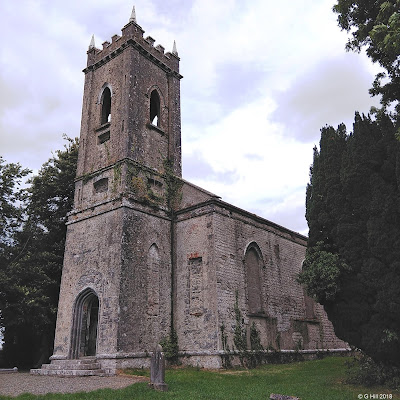Above Image: Entrance gate
Above Image: The approach to the ruins
Above Image: Church entrance
Above Image: View from church entrance of bridge
over River Blackwater
Above Image: Church interior
Above Image & Below Image: Swifte Mausoleum
This small but interesting ruin dedicated to St. Nicholas
sits upon elevated ground to the East of the nearby Blackwater River. The
location was once the site of a medieval church which was in ruin by the mid 1600’s and
sadly leaves no traces of itself behind. The present ruins are that of a
later church built for the protestant community on the old catholic church
ground. It is thought to have been built during the period of the board of
first fruits which began in the late 1790’s. There are records of this church
being in existence in 1837 so it certainly fits the brief. It was still in service until 1910 and was
de-consecrated in 1977. It is now roofless, overgrown and in ruin.
This is a particularly atmospheric site tucked away on an
intersection of two backroads. From the moment you enter the old entrance gate
and ascend to the graveyard it just reeks of antiquity. If you want to
demonstrate an example of an ancient burial site that wouldn’t be out of place
in a Gothic novel, well Castlerickard ticks all of the boxes and then some. There are
ancient table tombs, overgrown Celtic crosses and spectacularly at the rear of
the graveyard a huge 12 feet tall pyramid or tetrahedron which was built as a
mausoleum for the prominent Swifte family sometime around the 1820’s. It is
constructed of limestone blocks and dominates this part of the graveyard acting
like a tall black sentinel. The graveyard is mostly overgrown and the ground
underfoot uneven, but it holds a fascination somehow, probably due
to its location, construction and overall eeriness. We visited on an overcast
day between showers which just lent more grimness to the place. If you find yourself anywhere in the area do take some time out to see it. The mausoleum itself is worth the visit.
To find the ruins head West on the M4 and take the junction
8 exit and follow the roundabout around to the third exit signposted for the
R148 to Enfield. Continue on this road until you have either driven through or
around Enfield. Then continue on the R148 until you see a sign for the L2226 to
Longwood. Turn right onto the L2226 and drive for approx. 4.5KM until you reach a small roundabout in
Longwood with an antiques & curios shop opposite. Turn right here onto the
R160 and drive for approx. 1.5KM and take the first left hand turn. It is quite
well hidden and not signposted but there is a small derelict cottage opposite.
Drive up this narrow road for approx. 1.5KM until you reach a T-Junction. Turn
left and continue for approx. 350m then
take the first right hand turn. The graveyard gate is on your right a few
metres up. It is possible to park snugly at the gate.


























